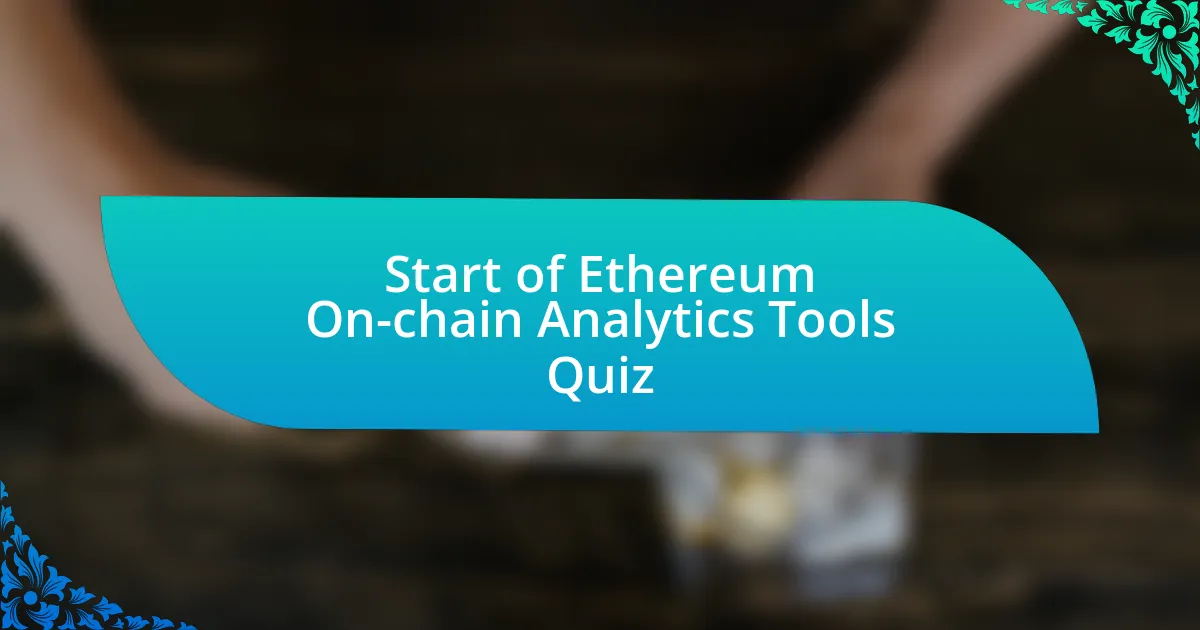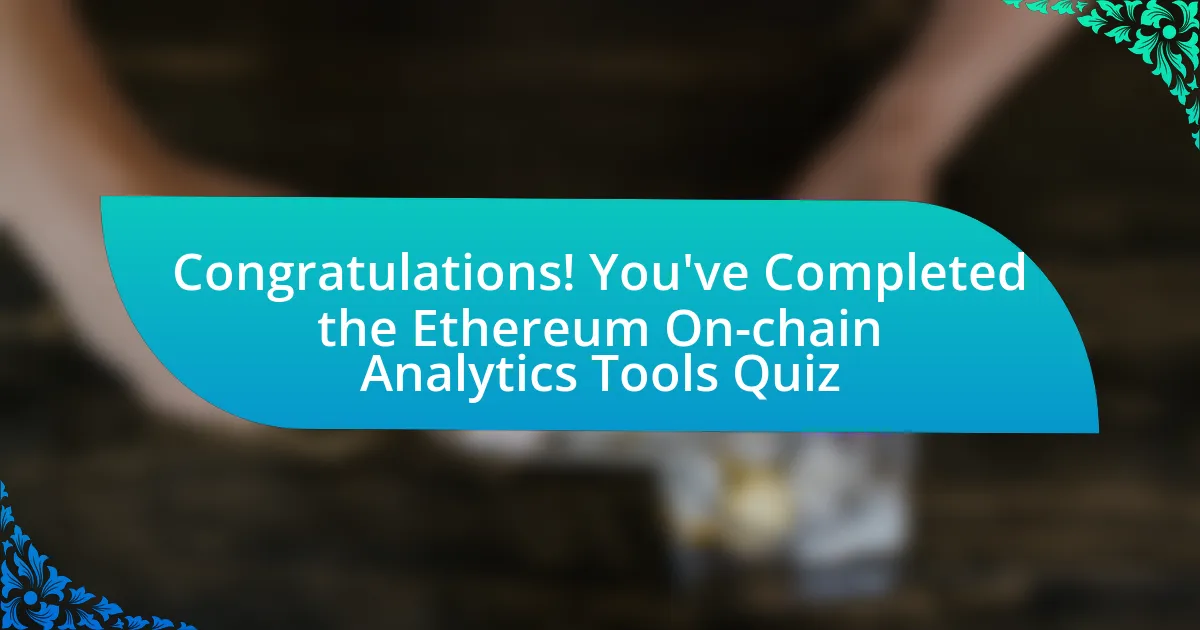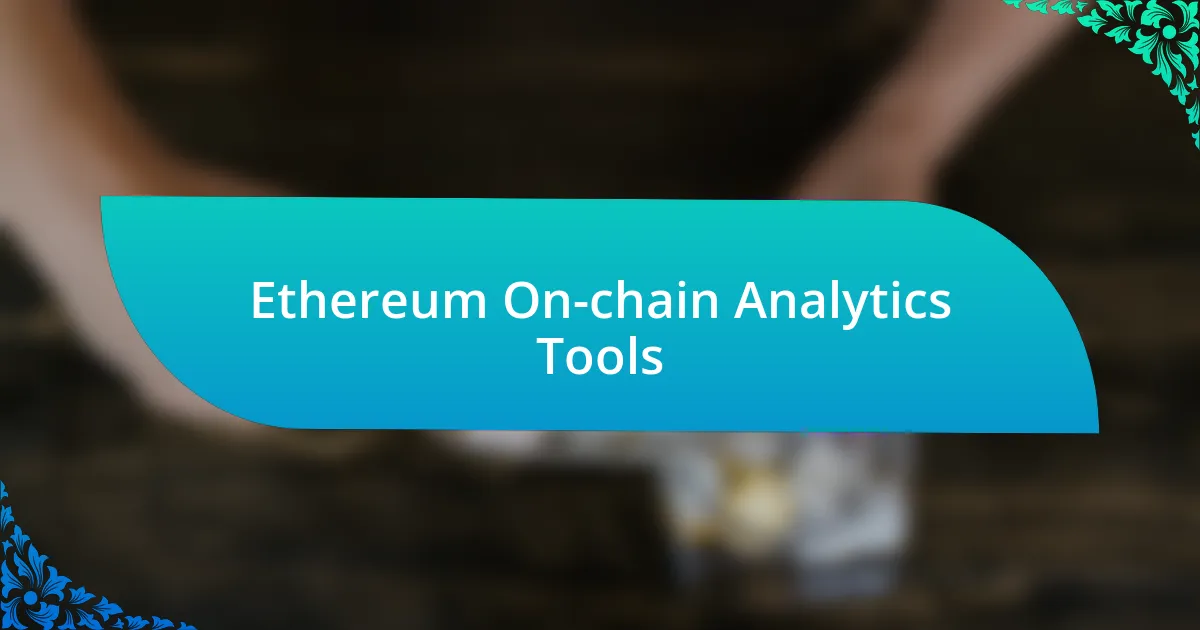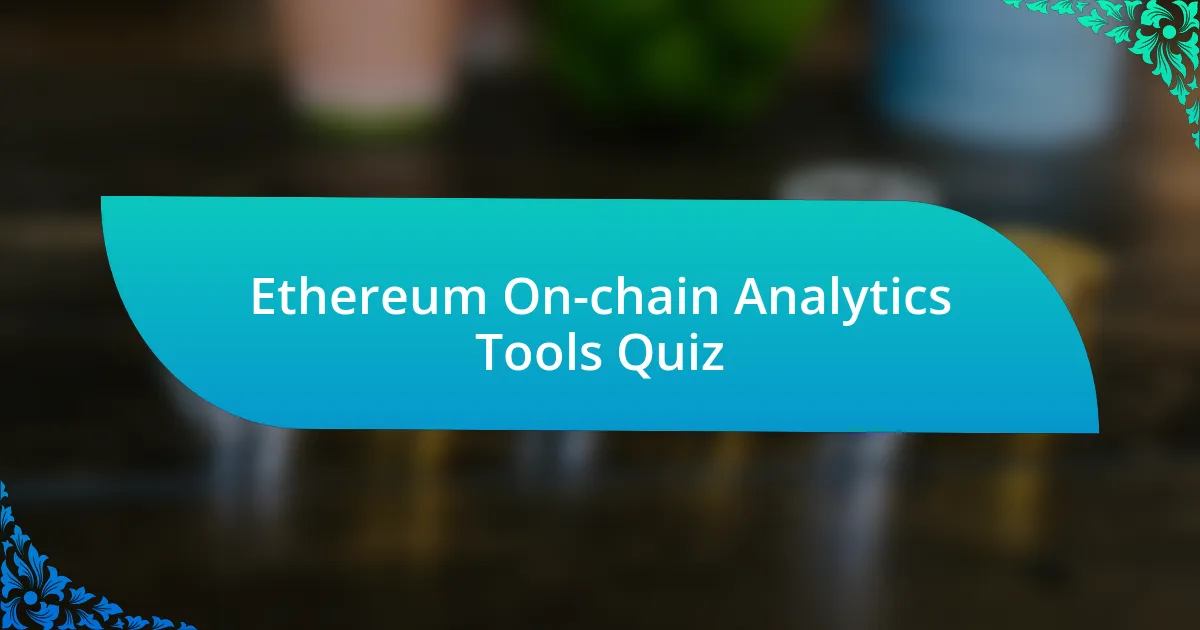
Start of Ethereum On-chain Analytics Tools Quiz
1. What is Etherscan?
- Etherscan is a wallet service for storing Ethereum.
- Etherscan is a cryptocurrency exchange platform.
- Etherscan is a mining software for Ethereum coins.
- Etherscan is a blockchain explorer and analytics tool for the Ethereum blockchain.
2. What are the key features of Etherscan?
- Automatic crypto purchases, personalized investment advice, and virtual asset collateralization.
- Simplified login process, built-in trading functionality, and cross-platform wallet synchronization.
- Private messaging for users, offline transaction processing, and social media integration.
- Early trend identification, real-time tracking of gas fees, detailed exploration of wallet addresses, and analysis of transaction blocks.
3. What does Messari offer in terms of on-chain analysis?
- Messari provides diverse charts, screeners, watchlists, and reports for analysis.
- Messari solely provides wallet tracking services for users.
- Messari focuses exclusively on trading strategies and market predictions.
- Messari only offers news updates and market forecasts.
4. What are the notable features of Nansen?
- Nansen issues cryptocurrency news updates.
- Nansen provides historical data analytics.
- Nansen focuses solely on NFT transactions.
- Nansen offers real-time dashboards and alerts.
5. What does Dune provide in terms of on-chain data analysis?
- Dune exclusively tracks NFT sales and trends.
- Dune provides decentralized wallet services for users.
- Dune operates as a trading platform for cryptocurrencies.
- Dune simplifies Ethereum data querying with SQL.
6. What is the primary focus of Glassnode in on-chain analysis?
- Social media trends analytics
- Market cap rankings for tokens
- On-chain indicators for traders
- Technical analysis for stocks
7. What are the key features of CryptoQuant in on-chain analysis?
- Basic data for small altcoins only
- Comprehensive insights into popular cryptos via API
- High-level summaries without data detail
- Limited metrics on fiat currencies
8. What does IntoTheBlock offer in terms of on-chain analysis?
- Advanced DeFi analytics
- Basic market tracking
- In-depth historical charting
- Simple transaction alerting
9. What is the role of Flashbots MEV Dashboard in on-chain analysis?
- Flashbots MEV Dashboard tracks gas prices for Ethereum transactions.
- Flashbots MEV Dashboard visualizes NFT trading activity in real time.
- Flashbots MEV Dashboard provides social sentiment analysis on cryptocurrency.
- Flashbots MEV Dashboard compares MEV statistics across the Ethereum blockchain.
10. What does Chainsight Analytics offer in terms of on-chain activity monitoring?
- Simple scorecards for cryptocurrency comparisons.
- Static images of blockchain transactions.
- Innovative dashboards for monitoring on-chain activity.
- Basic charts for historical data tracking.
11. What does EigenPhi HQ cover in terms of DeFi data analysis?
- Only asset allocation and portfolio tracking
- MEV, Front Run, Liquidation, Flash loan, and Lending
- Social media sentiment analysis and user profiles
- Trading volume and historical prices
12. What are the primary features of Dune MEV Dashboard?
- Analyzes MEV-performance of validator operators
- Tracks ERC-20 token prices
- Provides real-time transaction alerts
- Visualizes NFT market trends
13. How does Nansen cater to both crypto experts and newcomers?
- Nansen focuses only on expert-level resources and avoids user-friendly features.
- Nansen serves experts with complex graphs and ignores newcomers.
- Nansen is designed solely for novices without deep research options.
- Nansen caters to experts by providing advanced analytics and newcomers by offering simple tools.
14. What does Etherscan facilitate in terms of transaction monitoring?
- Tracking non-crypto banking transactions
- Monitoring transaction activities on Ethereum
- Managing user accounts on Bitcoin
- Overseeing private wallet transactions
15. What are the key applications of Glassnode in on-chain analysis?
- Glassnode provides in-depth reports of market indicators for several cryptocurrencies.
- Glassnode is a trading platform for buying and selling cryptocurrencies.
- Glassnode simply tracks the number of active users on exchanges.
- Glassnode offers basic price charts for Bitcoin only.
16. How does Dune simplify Ethereum data querying?
- Dune simplifies Ethereum data querying with SQL.
- Dune offers Ethereum data querying through a proprietary language.
- Dune restricts Ethereum data querying to APIs only.
- Dune relies on JSON data formats for Ethereum queries.
17. What are the primary features of Santiment in on-chain analysis?
- Santiment supplies comprehensive historical data, stock market analytics, weather-based trading systems, and sports event predictions.
- Santiment focuses solely on NFT creation, marketplace facilitation, artist promotion, and social media marketing for creators.
- Santiment offers integrated video tutorials, personalized coaching sessions, advanced coding courses, and exclusive webinars.
- Santiment provides accurate data feeds, low-latency signals, custom market watches, alerts, chart layouts, and tools for traders.
18. How does Nansen support multiple blockchains?
- Nansen only focuses on the Bitcoin blockchain for all its analysis.
- Nansen provides a single blockchain dashboard exclusive to Ethereum.
- Nansen restricts its analytics to only the Binance Smart Chain.
- Nansen supports multiple blockchains by identifying emerging trends across different blockchain networks.
19. What are the tools provided by IntoTheBlock for NFT analytics?
- IntoTheBlock provides real-time gas fee tracking for NFT transactions.
- IntoTheBlock specializes in blockchain gaming analytics for NFTs.
- IntoTheBlock gives detailed historical NFT price trends on each asset.
- IntoTheBlock offers comprehensive NFT analytics as part of its advanced DeFi analytics suite.
20. What is the role of EigenPhi in DeFi data analysis?
- EigenPhi is an in-depth DeFi data analysis platform that covers MEV, Front Run, Liquidation, Flash loan, and Lending.
- EigenPhi analyzes only the historical price movements of cryptocurrencies and provides no other data.
- EigenPhi is primarily a trading platform for buying and selling cryptocurrencies directly.
- EigenPhi focuses solely on social media sentiment and influencers in the crypto market.
21. How does CryptoQuant deliver market and on-chain data?
- Social media analytics platforms
- Email newsletters and calls
- Api and other data tools
- Text and spreadsheets
22. What are the primary features of Chainsight Analytics in on-chain activity monitoring?
- Manual entry for transaction data
- Innovative dashboards for monitoring on-chain activity
- Standardized templates for reports
- Basic graphs for cryptocurrency tracking
23. What does Flashbots MEV Dashboard compare in terms of MEV-Boost Relays?
- Flashbot MEV-Boost Relays with miners
- Flashbot MEV-Boost Relays with fees
- Flashbot MEV-Boost Relays with competitors
- Flashbot MEV-Boost Relays with transactions
24. How does Dune extract and organize blockchain data?
- Dune extracts blockchain data and arranges it into SQL databases that can be queried efficiently.
- Dune collects blockchain data using JSON format for web applications.
- Dune converts blockchain data into PDF files for easier distribution.
- Dune organizes blockchain data using XML files for greater compatibility.
25. What are the key applications of Santiment in market analytics?
- Santiment offers general news articles on market trends.
- Santiment primarily sells cryptocurrencies directly to users.
- Santiment is focused only on social media sentiment analysis.
- Santiment provides accurate data feeds and custom market watches.
26. How does Nansen support real-time dashboards and alerts?
- Nansen enhances network security through encryption protocols.
- Nansen prevents market manipulation by analyzing user transactions.
- Nansen supports real-time dashboards and alerts, providing users with invaluable insights into the dynamic crypto market.
- Nansen offers historical data analytics without real-time capabilities.
27. What are the primary features of Etherscan in transaction monitoring?
- Cryptocurrency regulatory compliance, exchange rate calculations, token issuance tracking
- Non-transparent transaction validations, automated smart contract creation, wallet recovery solutions
- Early trend identification, detailed exploration of wallets, real-time gas fee tracking
- Advanced pattern forecasting, wallet privacy analysis, off-chain data collection
28. How does Glassnode provide market intelligence in on-chain analysis?
- Glassnode focuses solely on traditional financial market data.
- Glassnode analyzes social media trends to predict market changes.
- Glassnode provides market intelligence and relevant data for crypto trading.
- Glassnode offers real-time price alerts for different cryptocurrencies.
29. What are the tools provided by IntoTheBlock for DeFi analytics?
- Cryptocurrency mining software for asset generation.
- Basic cryptocurrency wallets for transaction management.
- Social media tools for tracking influencer sentiments in crypto.
- Advanced DeFi analytics covering general market data and specific DeFi protocols.
30. How does Dune simplify data collection and visualization?
- Dune simplifies data collection and visualization by breaking down complex data into easy-to-understand information using charts and graphs.
- Dune generates random data which users can interact with for various analyses.
- Dune automates data entry without user interaction for visualization purposes.
- Dune requires extensive programming knowledge to visualize and collect data effectively.

Congratulations! You’ve Completed the Ethereum On-chain Analytics Tools Quiz
Thank you for participating in this quiz on Ethereum On-chain Analytics Tools. We hope you found the experience engaging and informative. Through this quiz, you’ve likely gained insights into various tools that analyze Ethereum’s blockchain data. Understanding these tools is crucial for anyone looking to navigate the complexities of Ethereum’s ecosystem.
You’ve learned about the significance of on-chain data analytics and how it can inform investment strategies, enhance security, and provide transparency in transactions. Every question was designed to enhance your knowledge and challenge your understanding of this evolving field. We trust you enriched your grasp of these essential tools by interacting with the quiz.
To further your learning, we invite you to explore the next section on this page dedicated to Ethereum On-chain Analytics Tools. This comprehensive resource will deepen your knowledge and provide practical guidance on how to effectively use these tools in real-world scenarios. Don’t miss the opportunity to advance your skills and fluency in this critical area of blockchain technology!

Ethereum On-chain Analytics Tools
Understanding Ethereum On-chain Analytics Tools
Ethereum On-chain Analytics Tools are software applications designed to analyze and interpret blockchain data specifically from the Ethereum network. These tools enable users to track transactions, monitor smart contracts, and assess token movements. They provide insights into user behavior and network activity. This analysis is crucial for investors, developers, and researchers aiming to make informed decisions based on real-time data and historical trends.
Types of Ethereum On-chain Analytics Tools
There are various types of Ethereum On-chain Analytics Tools, including explorers, dashboards, and monitoring platforms. Blockchain explorers like Etherscan allow users to view all transactions on Ethereum block by block. Analytics dashboards aggregate data for visual insights, while monitoring platforms focus on specific metrics such as gas fees or transaction anomalies. Each tool serves a unique purpose, catering to distinct aspects of on-chain analysis.
Key Features of Ethereum On-chain Analytics Tools
Key features of Ethereum On-chain Analytics Tools include real-time data tracking, visualizations, filtering options, and alerts. Real-time tracking allows users to see transactions as they happen, while visualizations help in understanding complex data patterns. Filtering options enable targeted analysis by different parameters, such as token type or transaction volume. Alerts notify users of significant changes, providing crucial information instantly.
Use Cases for Ethereum On-chain Analytics Tools
Use cases for Ethereum On-chain Analytics Tools span across trading, security auditing, and market research. Investors utilize these tools for trading strategies by analyzing price movements and trading volumes. Security professionals audit smart contracts by examining their transaction histories for vulnerabilities. Researchers employ these tools to study market dynamics and user engagement trends, leading to deeper insights into the Ethereum ecosystem.
Popular Ethereum On-chain Analytics Platforms
Popular Ethereum On-chain Analytics platforms include Etherscan, Glassnode, and Dune Analytics. Etherscan is primarily a blockchain explorer but offers various analytics functionalities. Glassnode focuses on on-chain metrics and provides a wealth of data on market indicators. Dune Analytics allows users to create custom queries and dashboards, making it versatile for specific research needs. Each platform serves different user requirements, enhancing the analytical capability within the Ethereum landscape.
What are Ethereum on-chain analytics tools?
Ethereum on-chain analytics tools are software applications designed to analyze data on the Ethereum blockchain. They provide insights into various metrics such as transaction volumes, smart contract interactions, and wallet activities. For example, tools like Etherscan and Dune Analytics allow users to track and visualize on-chain data, facilitating better understanding of network usage and trends.
How do Ethereum on-chain analytics tools work?
Ethereum on-chain analytics tools work by aggregating and analyzing data from the Ethereum blockchain. They access blockchain nodes to retrieve transaction details and wallet activities. Some tools employ algorithms to visualize this data, offering charts and graphs for easier interpretation, such as the number of active addresses over time or gas fees trends.
Where can I find Ethereum on-chain analytics tools?
Ethereum on-chain analytics tools can be found on various online platforms. Websites like Etherscan, Dune Analytics, and Nansen offer these functionalities directly through their interfaces. Additionally, some developers and companies provide API access for custom analytics solutions, allowing integration with other applications.
When should I use Ethereum on-chain analytics tools?
You should use Ethereum on-chain analytics tools when you need to make informed decisions based on blockchain data. For instance, these tools are useful for investors tracking market trends, developers analyzing smart contracts, or researchers studying network behavior. They can be valuable at any point where thorough analysis of transactions or user activity is required.
Who typically uses Ethereum on-chain analytics tools?
Ethereum on-chain analytics tools are typically used by cryptocurrency investors, researchers, developers, and analysts. Investors utilize them to monitor asset performance and market movements, while developers analyze network efficiency and smart contract usage. Researchers leverage these tools to study blockchain behavior and economics.

